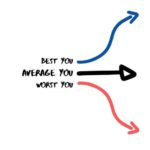When was the last time you tried to start a new habit?
Maybe you wanted to eat more vegetables, read every day, meditate, or stretch in the evenings. Whatever it was, did you stick with it?
Chances are the new habit didn’t last long. You probably kept it up for a week, maybe even a month, but sooner or later you gave it up and stopped doing it consistently.
On the other hand, perhaps you have started a new habit and it’s one you still do to this day. But let me ask you this: Do you know why that habit stuck? Could you repeat it again with a new habit?
What Triggers a New Habit?
Very often when we start a new habit, the inspiration stems from emotion. We fail in a critical moment or start to become unsatisfied with how we feel on a daily basis. We take a long hard look in the mirror, tell ourselves “I need to change”.
In this moment, we are often a little overambitious, and we tell ourselves we are going to change EVERYTHING. If we are more realistic, we choose one or two things we’d like to improve on.
But in either case, it is the initial emotion of dissatisfaction that creates momentum. And for a short while, we have what I call the “Window of Inspiration”.

During this window, we are willing to stop eating all sugar that crosses our path, we read 2 hours every day, and we go for the extra reps in every workout session. This window is an ideal time to improve ourselves, but the main issue is that it never lasts.
Willpower fades and ultimately our attempted habits fail.
What often follows is a string of negative self-talk, self-judgement, and a general sense of failure. We look at others around us who have achieved these habits that we are aiming for and blame our lack of willpower. We put these other people up on a pedestal and simply assume that they have something we don’t.
But I want you to listen to what I’m about to say very closely. Because it’s the one thing I want you to get from this entire article.
Failure in habit formation does not come from poor willpower, it comes from poor design.
The reason your habit didn’t stick isn’t because you are weak, dumb, unfocused, unmotivated, lazy, or useless. There is nothing wrong with you, but there is something wrong with your planning.
Using the B = MAT Model
Dr. B.J. Fogg is one the world’s leading experts in behavioral change and habits. He has studied and written extensively on the topic of habit formation and understands why people fail to start and stop them. He currently teaches at Stanford, but on his website, also provides resources for those looking to form new habits that last. One such resource is The Fogg Behaviour Model also known as B = MAT.
The Fogg Behavior Model can be summarized as follows: Behavior happens when there is motivation to do the behavior, there’s ability, and there’s a trigger.
If you are looking to start a new habit, follow along and think about it as I explain the BMAT Model. Start thinking about a new habit you’ve tried in the past or one you’ve wished you could start.
Behaviour
If you want to start a behavior you need to pick one. Obviously.
But more importantly, it needs to be specific.
For example, if you want to start meditating, decide what that practice will look like. How often will you do it? How long will it last? What style of meditation will you use? What time of day will you do it?
It’s tempting during our Window of Inspiration to just say to ourselves
“it doesn’t matter, I know I’ll do it when I need to.”
And this might last for a few days or even weeks. But without the specific requirements, it will become easier for you to justify taking a day off or not taking it seriously when you don’t feel like it.
Motivation
This goes without saying, but you should try to pick a behavior that you actually want to do. Don’t simply meditate because it’s what everyone else is doing. If you feel like you have a solid grasp on your mental game, don’t worry about it. If you’d rather work on eating healthier, go for it.
It is very challenging to create a habit around something you dislike and don’t see the reason for. But if you actually understand how a new habit could help you and pair that with the emotion formed during the Window of Inspiration, your chances of creating long term behaviour go up drastically.
Pro Tip: Habits will become more automatic when they are associated with a positive emotion. If you follow up the habit with a happy (and healthy) reward you are more likely to look forward to performing the new habit and actually doing it. (I try to only have chocolate milk on the days that I also go to the gym).
Ability
The issue that many people face when choosing a new habit is that they set the bar too high. They overestimate their ability during The Window and end up starting a new habit that requires consistently high levels of motivation.
Do you want to start working out four times per week? Why not just start with once per week?
You’d like to meditate every day? Start with only 5 minutes per day
I’ve used this approach in the past and written about a similar concept known as the Minimum Enjoyable Effort (MEA). More recently, however, I’ve used this strategy as a way to get myself to write every single day. Instead of just saying “I want to write more every day” or writing for an hour every day; I only have to write for 10 minutes – that’s it.
With such a small hurdle, I am far less tempted to skip out as it only requires so much motivation to get started. And often once I do get started, I end up going well past my timer. As this habit begins to shape and form into a routine, I will start to increase the time. My aim is to get it to 30 minutes per day by the end of the summer.
For yourself, choose a behavior that is within your current ability. Start out small as you need and work your way up. Don’t let your ego get in the way. If anything, underestimate your abilities and enjoy the satisfaction that comes from achieving something special every single day.
Trigger
The Golden Rule of Habit Change says that the most effective way to shift a habit is to diagnose and retain the old cue and reward and try to change only the routine. The cue or trigger for many of our habits are often in our subconscious. We barely even think about them and our brains can often function without us even realizing it. This is the reason you don’t have to retrain yourself every time you park your car. Your brain has already stored away the information deep inside and performs the behavior through habit.
If we are to be successful in adopting a new behavior it’s important that we establish and recognize ways in which we can trigger it. Find a way to implement that habit naturally. If you want to read more, keep a book by your bedside table. If you want to meditate, designate a specific chair in your living space that is only used for this activity.
On the flip side, if you are trying to stop a certain behavior, you can use this same line of thinking. If you’d like to stop checking your phone first thing in the morning, don’t use it as an alarm clock. Or if you find yourself checking Instagram too often, make it more difficult to access on your phone.
By understanding the triggers for a habit, we give ourselves a far greater chance of it sticking around as we allow ourselves to let them naturally occur in our day-to-day routine.
What’s Your New Habit?
Whether or not you are currently in the middle of a Window of Inspiration or just coming out of one, there is never a bad time to start a new habit. We all have something that we know we should be doing more of, but we just can’t seem to make the new behavior.
As I said before, there is nothing wrong with you or your willpower. You have everything that is necessary to start something positive, and the only thing missing is the proper design. Habits cannot be chosen and applied at random. They should be intentional, well thought out and organized around your ability.
If you follow B = MAT, I cannot guarantee success, but your odds of it increase dramatically. And if you do fail – refresh, rethink, redesign, and restart.
The Fogg Behavior Model: B = MAT Summary
Behaviour:
- Get specific on what behavior you want to turn into a habit
Motivation:
- Pick a behavior that you actually want to do and not one that you think you should do
Ability:
- Make the behavior as easy as possible
Trigger:
- Figure out how the behavior will fit naturally into your day
Final Thoughts
I said it before and I’ll say it again. The major takeaway that I want you to have from all of this is really quite simple. Failure to form a habit is not due to a lack of willpower, but instead due to poor design. You have what it takes, and you are capable of more, but you do have to be willing to think a little bit more about what you are trying to achieve.
Sometimes the best way to ensure a new behavior sticks is through telling others and creating accountability to those who listen. If you have a new habit that you want to start and you plan to use what we talked about today – comment below. If you are a little shy, send me an email at derek@dailyathlete.life
Keep grinding and stay focused.
-DT





